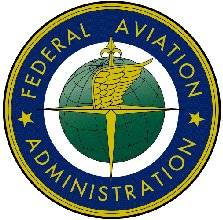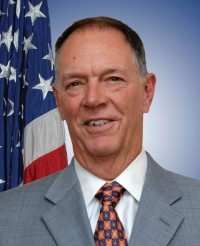System "Starts On The Ground At The Airport"
 FAA administrator Randy Babbitt
addressed the annual convention of the American Association of
Airport Executives (AAAE) on Tuesday, saying "We need NextGen, and
we need it now."
FAA administrator Randy Babbitt
addressed the annual convention of the American Association of
Airport Executives (AAAE) on Tuesday, saying "We need NextGen, and
we need it now."
Babbitt told the airport executives that while a lot of the
focus on NextGen has been on the space-based portion of the system,
"NextGen starts on the ground and it starts on the ground at the
airport." Babbitt said despite the current dip in operations, he
thinks the number of airplane movements will rise at least 20
percent in the next 10 years. And he said without infrastructure
construction and improvements it will be difficult for the system
to absorb that increase in traffic. "Even with a dozen-and-a-half
new runways and extensions over the last 10 years, it’s still
not enough. We need better surface management and better tools.
NextGen is both under way and on the way. It’s going to give
you the flexibility to deal with changing demand without investment
in costly infrastructure, or to meet demand in locations where new
pavement is not feasible. And NextGen will ensure that these
changes are made in an environmentally responsible manner."
But implementation of NextGen is also about safety on the
surface, Babbitt said. "... improved situational awareness is the
order of the day. With NextGen, pilots, controllers, and ground
personnel will have greater situational awareness, using moving
maps and sharing position and traffic data. The result: fewer
incursions, improved ramp safety, reduced taxi times, and decreased
emissions."
 "By now, most of you have heard
about Airport Surface Detection Equipment," Babbitt (pictured,
right) continued. "ASDE-X’s data distribution lets
controllers, traffic managers, airline operations centers and
airport operators see movement of aircraft vehicles on the airport
surface. This includes the ramp areas. Surface management
demonstrations using shared ASDE-X data at Kennedy and Memphis
showed that taxi times can be reduced on average from 2-4 minutes.
ASDE-X is now up and running at 27 airports with eight more to
come."
"By now, most of you have heard
about Airport Surface Detection Equipment," Babbitt (pictured,
right) continued. "ASDE-X’s data distribution lets
controllers, traffic managers, airline operations centers and
airport operators see movement of aircraft vehicles on the airport
surface. This includes the ramp areas. Surface management
demonstrations using shared ASDE-X data at Kennedy and Memphis
showed that taxi times can be reduced on average from 2-4 minutes.
ASDE-X is now up and running at 27 airports with eight more to
come."
Babbitt also reminded the airport executives that NextGen was
about more than just major metropolitan airports. "Small airports
will benefit as well. If you don’t have an ILS, the Wide Area
Augmentation System’s localizer performance with vertical
guidance procedures can provide precision approaches to near
Category 1 ILS minimums where feasible. As of May, we’ve
published more than 2,000 LPV approaches serving a thousand
airports. And 1,215 of those are to non-ILS runways. Other than
approach and runway lighting, WAAS does not require any additional
equipment on the ground. These new approaches increase safety and
improve access for a much larger number of airports."
ADS-B will also make significant improvements in tracking
aircraft, Babbitt said, pointing out that the GPS-based system is
more accurate than radar, and already operational in the Gulf of
Mexico, Louisville, KY and Juneau, AK. And the system's Wide Area
Multilateration (WAM) allows controllers to see airplanes where
ground-based radar can't reach.
Babbitt said while the future holds both improvements in
physical infrastructure and technology, that is still not a
complete solution to congestion and flight delays. "We’ve put
in quite a bit of concrete, and there’s more to come. And
NextGen is going to do quite a bit on its own as well. But new
runways and modernizing the system won’t get us where we need
to unless we commit to more sensible scheduling practices.
We’re seeing scheduling practices in Atlanta, Chicago and San
Francisco that are exhibits A, B and C of what not to do."

"NextGen is a gigantic leap forward for us; a gigantic step
that’s well under way," he concluded. "But with that as
context, I must say one more time that safe flight begins and ends
at an airport. I intend to do whatever it takes to keep it that
way."
 ANN's Daily Aero-Term (04.14.24): Maximum Authorized Altitude
ANN's Daily Aero-Term (04.14.24): Maximum Authorized Altitude ANN's Daily Aero-Linx (04.14.24)
ANN's Daily Aero-Linx (04.14.24) Classic Aero-TV: 'We're Surviving'-- Kyle Franklin Describes Airshow Life 2013
Classic Aero-TV: 'We're Surviving'-- Kyle Franklin Describes Airshow Life 2013 Aero-News: Quote of the Day (04.14.24)
Aero-News: Quote of the Day (04.14.24) Airborne 04.09.24: SnF24!, Piper-DeltaHawk!, Fisher Update, Junkers
Airborne 04.09.24: SnF24!, Piper-DeltaHawk!, Fisher Update, Junkers





